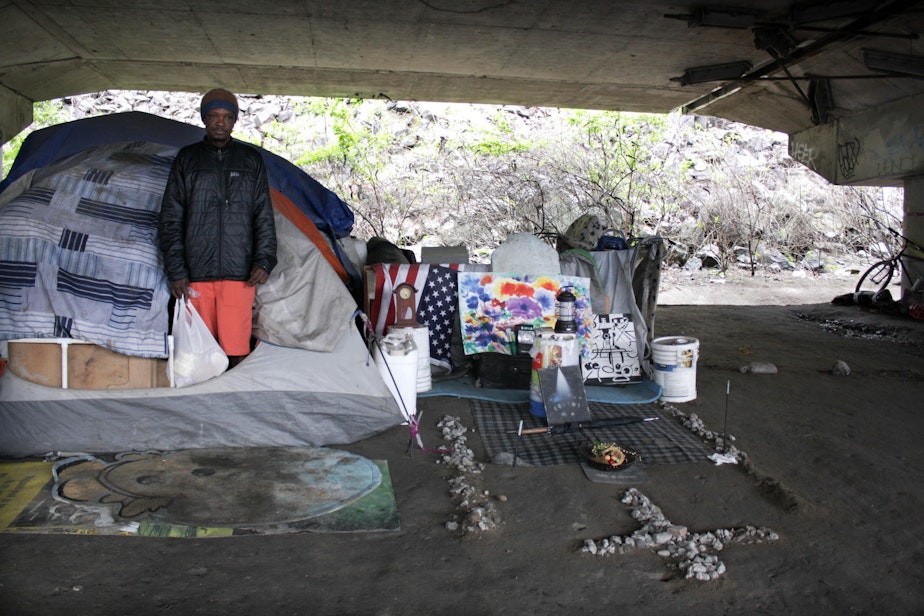Most Jungle residents remain on the streets one year after shooting

On January 26, 2016, five people were shot in Seattle’s largest homeless camp, a stretch of greenbelt under Interstate 5 known as the Jungle.
The shooting thrust the camp into the spotlight and city officials immediately vowed to shut it down.
In the intervening year, they've made good on that promise and the camp has been cleared.
Where there used to be tents, trash, campfires and people, there's now just bare, muddy earth. And most of the residents who once called the camp home are still on the streets.
Jason Johnson, Deputy Director of Seattle’s Human Services, said the Jungle was unfit for human habitation and had to be cleared.
Sponsored
The city's main goal was to move people living in the camp out of a dangerous environment, he said.
"If you can move someone from an unsafe place to a safer place, even if they remain unsheltered, that's better."
Top Read: Seattle to Trump: We will not be bullied
There were nearly 400 people living in the Jungle after the shooting. Now, most of those people have scattered to other tent camps around the city.
"What the city wanted to do was to empty out the Jungle. The goal was never to say we're going to provide housing for everyone in the Jungle," said Jeff Lilley, president of the Union Gospel Mission (UGM).
Sponsored
Lilley's group was tapped by the city to conduct outreach in the Jungle.
"One of the things that happened with us and the city was we were having conversations that you shouldn't just go in and sweep them. We have a phrase: Homelessness is not so much a resource issue as it is a relationship issue," he said.
And UGM outreach workers have built the necessary relationships, according to Lilley.
They’re still offering help to those who scattered to other encampments, he said, and they feel everyone is better off outside the Jungle.
“Those who moved out of the Jungle into some of the other encampments are now in encampments that we can deliver port-a-potties, we can have trash there, we can go in and visit, other service providers will now come, police can be there."
Sponsored
Lilley said many of the people in the Jungle struggled with addiction and were chronically homeless. And that made it hard to get them into services.
Over about six months, UGM contacted nearly 400 people in the Jungle. In the end, 87 people accepted services. Of that group, early reports show only a fraction ended up indoors.
A UGM report from June, 2016, shows the majority of people who were accepting services at that time were simply getting assistance moving to other tent encampments, both authorized and unauthorized.
Others were helped into recovery programs, transitional housing, hotels and stable housing. Some of the people who got into housing have since lost it again.
Despite the low number of people indoors after six months of intensive outreach, the city’s Jason Johnson said they count this effort as a success.
Sponsored
"The number is low. I think if I wasn't in this work I would probably see this number and think that it was unsuccessful," Johnson said. "But knowing the length of time it takes and the hard work and effort that it takes to get someone indoors, I now understand that number to be a number of success."
For Cheryl Oliver, that success is very real. UGM helped Oliver and her family connect with a rent assistance program.
They're currently living in a motel and looking for an apartment.
"It took a little while after the shooting but it did end up being better off for us because we've been in housing ever since," Oliver said.
Oliver said she was never afraid in the Jungle. However, since being in the motel, Oliver's husband has landed a job at McDonald's and things are looking up.
Sponsored
Tim Harris, homeless advocate and director of Real Change street paper, believes Oliver is in the minority.
"I'm sure that there's a number of people who are in better situations right now, but for every one of those people there's probably two more who are still camped outside, who are probably camped more remotely, who have been removed from the community that they were in."
Harris said one thing the city failed to do in this effort was take the agency of homeless people seriously.
"They think that if they remove the alternatives for people to sleep out, or if they make it unpleasant enough, or move them around enough that eventually they'll come inside or go somewhere else. And what really happens is that people just adapt, they're lives become more miserable from the additional stress and they become harder to find."
The city and UGM say even though the Jungle has been cleared, the work is not over.
Outreach continues and the city has revamped their approach to homeless services.
The city is also working to open a new low barrier shelter called the Navigation Center. This would be a shelter better suited to take in people with addiction issues, pets, partners or belongings, the kinds of things that might keep someone out of a traditional shelter.
The center was supposed to open in December but it's been delayed. There's still no word on when it will be up and running.
